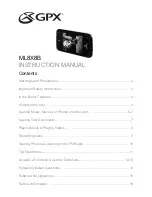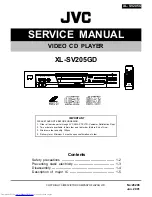
Chapter 4
Dubbing to another equipment using i.LINK jack, Duplication, Audio Dubbing, and Connecting with a Computer
Chapter 4
Dubbing to another equipment using i.LINK jack, Duplication, Audio Dubbing, and Connecting with a Computer
61
Dubbing sound
1
Connect AUDIO INPUT jack of the unit and the
sound source using a phono jack cable (not
supplied).
2
Set INPUT SELECT switch to a setting other than
HDV/DV.
3
Switch AUDIO INPUT LEVEL switch to select
the audio input signal level (–10, –2 or +4).
4
Play back the tape inserted in the unit.
5
At the point you want to start dubbing, press
PAUSE button to turn the unit to the playback
pause mode.
6
While holding AUDIO DUB button down, press
PLAY button to turn the unit to the audio dubbing
pause mode.
AUDIO DUB indicator on the unit lights.
7
Set AUDIO INPUT switch to set the adjusting
method of the recording level.
8
Adjust the recording level by turning AUDIO REC
LEVEL control knobs.
You can adjust the recording level with AUDIO
REC LEVEL control knobs if you have selected
MANU in step
7
. While looking at the audio level
meters on STATUS CHECK screen, turn AUDIO
REC LEVEL control knobs and adjust the
recording level. Adjust the audio recording level so
that the recording level does not exceed 0 dB when
the audio signal is at its maximum. If the recording
level exceeds 0 dB, the sound will be distorted.
9
Press PAUSE button.
PAUSE indicator goes off and audio dubbing
starts.
To pause audio dubbing
Press PAUSE button.
Pressing PAUSE button again resumes audio dubbing.
To stop audio dubbing
Press STOP button.
To monitor the sound you want
Set AUDIO OUTPUT SELECT switch as follows:
CH-1/2:
You can listen to sound recorded on
channels 1/2 on the tape.
CH-3/4:
You can listen to sound to be dubbed on
channels 3/4.
MIX:
You can listen to the sound on the tape and the
dubbed sound.
For details on the audio levels display in the audio dubbing
mode, see page 27.
Notes
• You can monitor the sound on the tape while dubbing
the sound. However, there are some delays between
the sound being recorded and the sound being played.
When you play back the tape after audio dubbing,
you might hear the dubbed sound later than the sound
monitored during audio dubbing.
• You cannot dub sounds onto a blank portion of the
tape.
















































